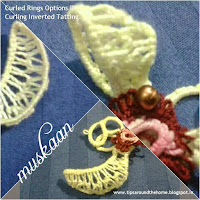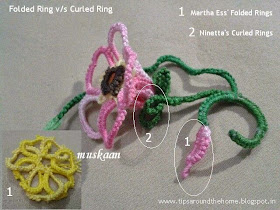 |
| Jewelry Medallion (free pattern) |
Curled Rings Options (Final)
As promised, this is the last
post on the subject. Thank you, dear readers, for your immense patience &
support. There are many more ways these rings can be used to great effect. It
is up to you to discover them now ;-P
I. Large
Ring
A simple coaxing will make
the large ring turn into figure ‘8’.
When curled up (picot folded from front to lie over the base of ring)
Curling behind gives a better shape
II. Large Ring with offset picot
‘Normal’ curl leads
to an asymmetrical cup with great potential for 3D applications.
Think of a bead within ! Or if picots
are added, then these can be joined later to other elements.
Or coax the ring into an '8' & curl. Interesting effects !
Both the large rings (I & II) were used in the pendant I shared here
III. Bead at Base of a Curled Ring (outside) :
This is how I added a bead at the base of rings in the Curly Cross Pendant :(all beads shown with an asterisk in the notated pic in post). The Curl & Bead are made at the same time, with a single join.
Please note : There may most
certainly be better methods suited for this. I hope to improve as I learn more.
This method is something I figured was working fine (I had the bead exactly in
the spot I wanted) without causing me to loose focus hunting around.
IV. Bead inside a Curled Ring
Just as one would for a
normal ring, the bead is held at back of thread around the hand
& brought
into position when the ring is closed. Curling is done, as usual, later.
V. Curled Ring around a Split Ring
Ninetta has used these in her bookmark tail, here.
She recommends leaving a length
of thread space to continue between the SR & CR.
VI. A Curled Single Shuttle Split Ring (SSSR)
Since the bracelet was already made, I used some auxiliary thread to add an SSSR & curl it,
in order to get a toggle here.
VII Inverted
Tatting Curled !!!
Simply experimenting with the curled look. Makes for a gossamer petal !
Definitely going to use this in future 3D projects
ooooooooooooo
My final
thoughts / observations
As with so many techniques,
some factors are universal, to bring out their real effect & aesthetics ..
.
Thread Colour : Lighter shades if using a single
colour . Variegated ?
Thread
Size : Finer threads – upto size 20.
Joins : Choice would depend on colour(s) used, how the
rings are to be curled, etc.
Eg. Lock join is preferable
for free-standing multiple curled rings, since it provides greater stability.
Adjacent CRs can be joined to
each other like normal rings, as well as to other elements through the
inclusion of picots . eg. the Jewelry Medallion, etc.
Picot
Length : Small picot preferable. I
experimented with longer picots, but it did not work out. However, I still
believe, if done correctly, it should work. Experimentation for the future.
Rings : Split Rings, Josephine Rings, small rings (less than about
20ds) will be difficult to curl, if at all.
Sides : There is
a distinct front & back side in curling. For Curl Over rings, it does not
matter much & convenience is paramount. However, in Curl Around , etc. care
should be taken ; here, the curl should be from back to front, such that the
picot is lying above the base. The difference is clearly visible in the mistake
(shown within ring) I made in the golden Curly
Cross Pendant .
Notation for Ninetta's Curled Rings :In response to a thread in Craftree, Judith Connors points out that these curled rings are “more of an
effect than a technique”. Hence notation/direction can be added after the ring
count, with an explanation for the type of curling used either there, or in the
glossary.
eg. R : 12-12. Cl. CR or R
: 6-6-6-6 . Cl. Curl Around chain. [Cl –
close ring ; CR Curl Ring]
For a great tutorial on how to make a Curled Ring from the master designer herself, check out the Curled Rings Pendant lissted in the Patterns page on Ninetta's blog.
ooooooooooo
Jewelry Medallion
a free pattern
a free pattern
A very simple, beginner's pattern. I am, myself, just starting out with beads & have probably used some very basic methods. Although yet to try any of her gorgeous patterns, I am certain this medallion (especially the placement of 4 silver beads) was inspired by some of Corina Meyfeldt's pieces.
Click to download pattern in pdf format : Jewelry Medallion
UPDATE : The pattern now has a diagram to go with it . You can download it here : Jewelry Medallion [Earrings]
In order to add findings to the tip of a diamond arrangement of beads on a ring, here is a pictorial
Hope you enjoy the pattern & share or give feedback
UPDATE : The pattern now has a diagram to go with it . You can download it here : Jewelry Medallion [Earrings]
In order to add findings to the tip of a diamond arrangement of beads on a ring, here is a pictorial
Hope you enjoy the pattern & share or give feedback
happy tatting :-)
Motif #20/II for 25 Motif Challenge
Related Posts : my 3D pendant















































